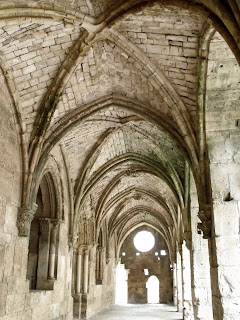We definitely heard right. We spent hours walking up and down the Orontes River, admiring the water wheels that are Hama’s claim to fame. The wheels aren’t only an experience for the eyes—they spray refreshing drops of water on you as you pass by, and creak and groan like a Jack White guitar dirge. Around them there are gardens and park areas, and the hill where the citadel used to be is now a playground and shady green place where you can grab a bench and watch the sun set over the city. We stayed at the Riad Hotel, which I highly recommend.

The people of Hama are, as is typical of Syria, so nice you can’t believe it. One family yelled hello at us from across the river while their son climbed up onto a rock and leapt into the water again and again, demanding that we watch and take photos. Despite the no swimming signs, Syrian boys leap in and out of the water like otters. At a gatehouse on one of the bridges, a couple of bored guys invited us in to get a great view of the water and look at ancient millstones. A girl my age and her mother walked us from the bus station to the city center, partially to make sure we got there and partially just to get to know us a little. It’s hard to believe that the best-known moment in Hama’s history was the massacre by the government of thousands of members of the Muslim Brotherhood.

While staying in Hama, Dan and I made trips to Krak des Chevaliers and to Apamea. Krak des Chevaliers is a medieval crusader castle that was eventually taken over by the Muslim army, so carvings throughout the castle display both European and Islamic artistic influences. The main joy of the castle, as with so many other sights in Syria, is that you are left alone to wander into dark corridors, climb to the tops of towers, and go running along the ramparts. There is even a moat, though there isn’t much water in it. It’s shimmery and attractive until it becomes clogged by a film of green slime so thick that there are no more waves—the sludge gently undulates and takes the half-submerged Coke cans with it. Krak is supposed to be the one of the best castles in the world, and while it lacks fairy tale beauty, it is dangerous and impressive and not a castle I feel like besieging anytime soon. Aside from Petra, it was the only tourist spot we’ve been to where I noticed large numbers of people.

Our other big stop in this area was Apamea, a set of ruins that marks the former home of the philosopher Numenius of Apamea. The ruins aren’t as impressive as Palmyra’s, and they are a bit hard to explore because the place is overrun with thorny weeds, but the Apamea is heart-stoppingly beautiful. Everywhere you look you can see ancient stones rising up out of bright green grass, backed by bright blue sky. At the end of one of the roads, there was a lake we couldn’t resist dipping our toes into. My sandals squelched in the red mud and as frogs sensed me coming they dove into the water with satisfying plops. Back on dry land, lizards of all sizes scuttled along the path in front of us and up arches and columns. As at Palmyra, motorcycle merchants approached us and offered their wares. Most of these guys claimed to be selling ancient coins (they say that their kids find them around the site). It’s extremely common to be offered coins or other possible antiquities, a trend I started to notice at Petra. Despite vendor claims of authenticity I hope they are all fakes—if they are the real deal, it is unethical and illegal to buy or sell them.

1 comment:
Such a good writer. I love the line about "creaking and groaning like a Jack White guitar dirge."
Post a Comment